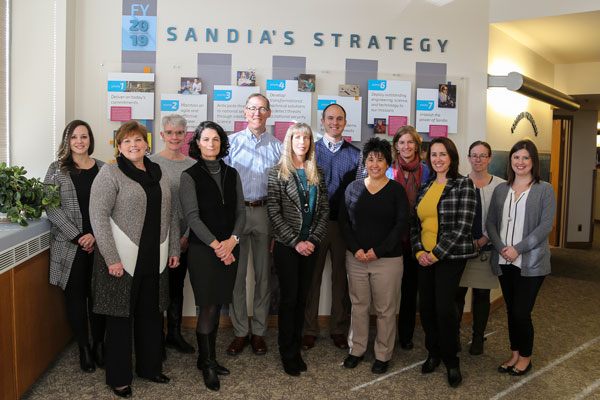In a changing world with evolving threats, yes, it does
Google “strategic planning criticism” and a lot comes up. Articles in prominent publications like the Harvard Business Review have titles like “The Big Lie of Strategic Planning,” “The Case Against Strategic Planning” and “The Strategic Plan is Dead.”
Ouch. As a strategic planner, that hurts.
Maybe strategy doesn’t produce results in some business settings, but at Sandia it’s critical, it’s in our DNA and it’s something of which every Sandian is a part. In a rapidly changing geopolitical world with numerous evolving threats, our role is unique and vital. The superpower race is real. Adversaries of the United States are making sophisticated technical advances that endanger our national security.
How do we stay ahead of our rivals, outmaneuver and out-invent them and avoid technical surprise? This question goes to the heart of our national security and is the reason Sandia exists. In this dynamic environment, it is imperative that Sandia stewards its work into the future with a thoughtful and significant strategic intent focused on breakthrough ideas for national security.
Seven Labs priorities

That’s where we all come in. Over the past three years, Sandia developed a strategic direction made up of seven priorities to guide the Labs for the next 20 years. It was pinched, pulled, twisted, teased and, finally, sent out into the Sandia world, where people like you took it and turned it into something solid. It climbed off the pages and became actions that impact the way we do our jobs.
Each priority has a team behind it, working to implement the strategy. The Sandia Lab News recently concluded a series of columns, each featuring a different priority and written by an associate Labs director champion who explored and explained its vision, goals and activities. They stopped short of patting themselves on the back.
That’s what I want to do here. I want you to know that teams have brought these priorities to life and accomplished plenty. Projects are happening, data is being collected, changes are being made. Most importantly, the work continues.
Here are key accomplishments from the past year:
Maintain an agile and effective nuclear deterrent. The team summarized key technical challenges across all the areas it touches. Five major areas were identified: agile testing, hostile environments, resilient barrier designs, trusted and survivable logic structures and data management. Plans are being developed to push those areas forward in fiscal year 2020 and beyond. The team’s work will dovetail with the Labs’ Nuclear Deterrence 3.0 strategy.
Anticipate threats to national security through intelligence science. The team developed a technical framework for thinking about complexity science and identified three critical areas: human systems theory, data analytics and decision science. The framework, which was validated through a targeted case study, will be used to screen, select, evaluate and refine potential R&D and science questions.
Develop transformational technical solutions to detect threats to national security. Two primary objectives were addressed: understanding gaps in detection capabilities and understanding R&D needs for development and deployment of adaptable and reconfigurable sensors and sensor architectures. The team conducted brainstorming sessions with subject matter experts across the Labs to collect diverse input and sponsored an effort to identify credible scenarios for improved threat detection.
Invent and demonstrate pathfinder systems to address threats. A team that crosses mission areas and Labs strategic priorities used its broad knowledge to come up with a list of seven viable pathfinder ideas. It developed a set of principles for selecting candidate pathfinder systems and is now working with programs to integrate the pathfinder ideas into our technical work.
Deploy outstanding engineering, science and technology to our missions. Deep dives were done into several topical areas: Assessing the impact of geoengineering; Inherently safe, resilient, modular nuclear weapons; Mission impact of Z-next beyond NW; Non-nuclear strategic weapons; and From bits to brilliance. About 100 people Labs-wide participated in workshops in each area, producing white papers that will become research initiatives sponsored by associate Labs directors.
Unleash the power of Sandia. Four strategic pillars for unleashing Sandia’s power were identified: operational effectiveness, creative thinking and innovation, empowered workforce and exceptional institution. The team developed a near-, mid- and long-term roadmap to implement cultural changes that will remove barriers and improve agility and decision-making. This team’s work directly informed the fiscal year 2020 strategic goal to “radically improve how we deliver the mission” and several other Labs-level objectives.
Engagement across the Labs
Sandia’s strategy touches all organizations and reflects the local character and expertise of our rich and diverse portfolio of technical and operational activities. Labs leadership plays a key role in strategy, and we look forward to the engagement of our new Labs director, James S. Peery.
We move toward this future together through the decisions we make. Big and small, they influence our behaviors and impact how Sandia delivers. In everything we do — strategy, operations, processes and people — we must keep an eye on the horizon and move the Labs ever closer to the tomorrow we envision. Initiatives and activities are driven by the desire to position the Labs for the years ahead.
Everyone’s help is needed to make Sandia’s strategy ever more inclusive. Employees can visit strategicplan.sandia.gov or email the strategy team at strategy@sandia.gov to get involved.
What we do today will keep us ready when duty calls — now and 20 years from now.